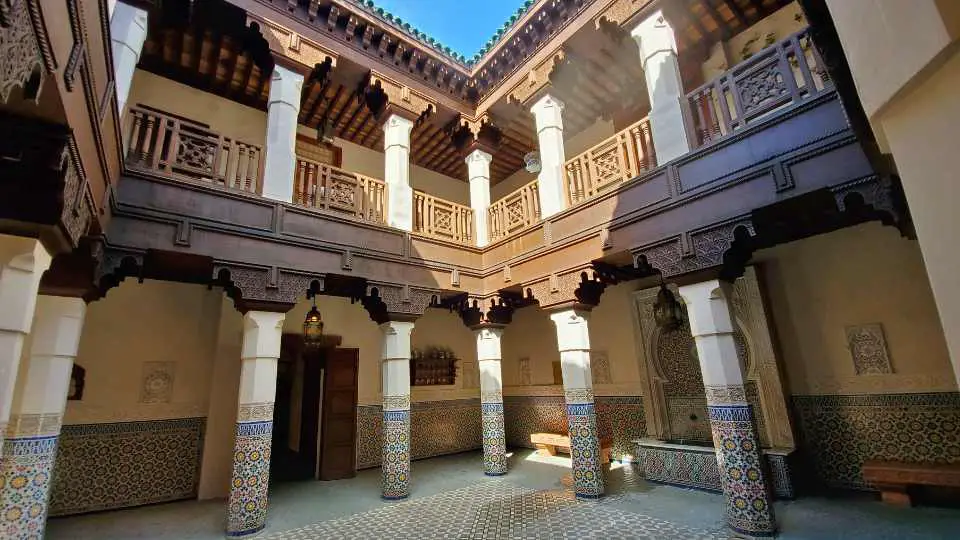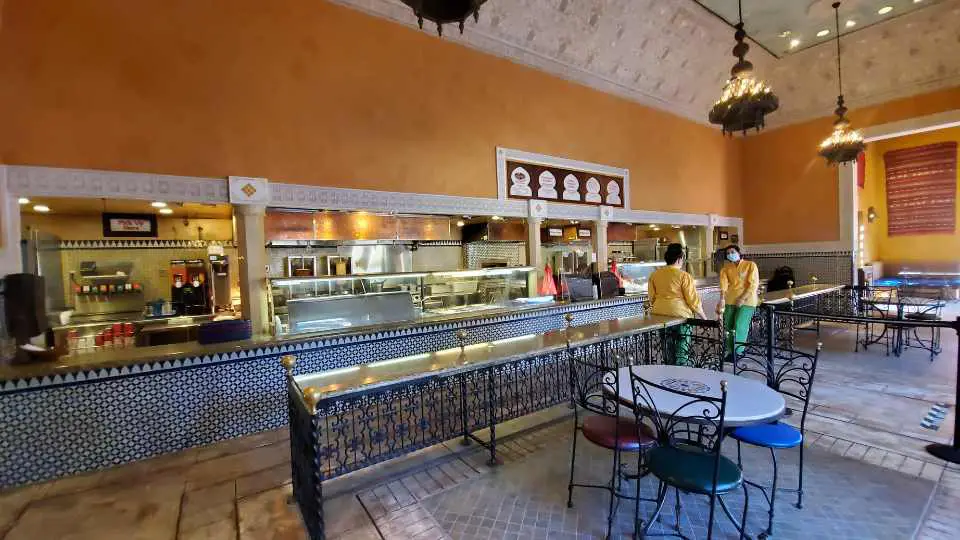Morocco Pavilion at Epcot: Walt Disney World’s Cultural Oasis Unveiled
Nestled between the pavilions of Japan and France within Epcot’s World Showcase at Walt Disney World, the Morocco Pavilion stands as an immersive tribute to the North African country’s rich culture and history.
Since its opening on September 7, 1984, the pavilion has offered visitors a chance to experience the vibrancy of Moroccan life through its meticulous architectural reproductions, including a replica of the Koutoubia Minaret of Marrakesh. This landmark not only acts as a welcoming sign to the pavilion but also symbolizes the detailed craftsmanship that represents the Moroccan aesthetic.
The Morocco Pavilion is unique among the Epcot showcases in that the Moroccan government was directly involved in its creation, ensuring a high level of authenticity in the design and cultural representation. Guests can stroll through the bustling marketplace filled with intricate artisanal goods, dine in restaurants serving traditional Moroccan cuisine, and enjoy entertainment that reflects the country’s artistic traditions.
About the Morocco Pavilion
The Morocco Pavilion at Epcot’s World Showcase in Walt Disney World stands as a testament to cultural exchange and international collaboration. Its history dates back to the early development of Epcot, with definitive plans taking shape in the early 1980s.
Initiated under the guidance of King Hassan II of Morocco, the pavilion was designed to bring an authentic slice of Moroccan culture to Florida. Unlike other pavilions, its development involved direct contributions from the Moroccan government. Moroccan artisans employed traditional methods to craft the pavilion’s intricate mosaics and architecture, ensuring a genuine representation of their homeland.
When the World Showcase opened in 1982, the Morocco Pavilion was conspicuously absent, not due to join until later. Finally, on September 7, 1984, the pavilion welcomed its first visitors, becoming the first new addition to the World Showcase lineup.
The pavilion did not feature a traditional corporate sponsor, differing from other nations represented around the lagoon. Instead, its creation was supported directly by the Moroccan government, a unique aspect that emphasizes its authenticity.
The Pavilion’s narrative extends beyond its architecture. It also hosts a thematic attraction, “Race Against the Sun”, chronicling the challenges and innovations of Moroccan transportation and sustainability efforts.
The pavilion’s story is ongoing, with updates and cultural additions evolving with the times while staying true to its original spirit. It remains a beloved part of Epcot, offering guests a passage to North Africa amidst the magic of Walt Disney World.

Design and Architecture
The Morocco Pavilion at Epcot’s World Showcase is a testament to the North African country’s rich heritage in design and architecture, reflected in its detailed buildings and landscapes that capture the essence of Moroccan aesthetics.
Influence and Style
Morocco’s architecture is renowned for its intertwining of Islamic and Mediterranean influences, which is evident throughout the pavilion. The pavilion’s design embodies a wealth of geometric patterns and mosaics, a hallmark of Islamic art, avoiding the depiction of living forms in favor of intricate, abstract designs. Traditional tiles, known as zellij, are meticulously assembled to compose breathtaking patterns that adorn the walls and fountains, making the pavilion a vibrant display of Moroccan tradition and craft.
Visitors to the pavilion will feel as if they’ve walked into a Moroccan medina; a labyrinth-like urban layout that includes marketplaces, winding passageways, and bustling courtyards – each corner offering a realistic glimpse into Moroccan city life.
Iconic Structures
Within the pavilion, two noteworthy structures stand out:
- The Prayer Tower – This structure is inspired by the Koutoubia Minaret in Marrakesh, a famed 12th-century tower that is an iconic example of Moorish architecture. The pavilion’s prayer tower mirrors the minaret’s ribbed design and the use of decorative arches, serving as a visual focal point.
- The Replica of Koutoubia Minaret – The pavilion’s version of the Koutoubia Minaret acts not only as a decorative tower but also as a religious structure symbolizing Islamic faith. Towering above the pavilion, it showcases the importance of minarets as landmarks and reflectors of cultural identity.
The composition of these structures within the pavilion is meticulously planned to represent a Moroccan city’s skyline, creating an immersive experience that transports visitors to the heart of Morocco’s famed cities without ever leaving Florida.

Attractions and Entertainment
At Epcot’s Morocco Pavilion, guests are enveloped in a world of traditional Moroccan culture, from the intricate artistry to the vibrant entertainment. The attractions offer a detailed look into the history, music, and characters that are integral to Moroccan heritage.
Gallery of Arts and History
The Gallery of Arts and History hosts the Race Against the Sun: Ancient Technique to Modern Competition exhibit, showcasing Morocco’s rich history and connection to both ancient practices and contemporary sports. The gallery immerses visitors in the story of the country through authentic artifacts and detailed displays.
Music and Performances
Morocco Pavilion is a hub for music and performances, celebrating the dynamic sounds of Moroccan music. Traditional belly dancers grace the stage with their art, while bands often perform styles synonymous with Moroccan culture. During various festivals, the pavilion comes alive with special music and performance events.
Characters Meet and Greet
For those hoping to meet Disney’s famous Aladdin and Princess Jasmine, the Morocco Pavilion offers a magical opportunity. The Characters Meet and Greet area allows guests to interact with these beloved figures, capturing memorable moments. Sometimes, the Genie makes an appearance, brightening the experience with his humor and charm.
Dining Experiences
At the heart of EPCOT’s Morocco Pavilion, the dining experiences transport visitors to the streets and courtyards of a Moroccan city, where flavors are as rich as the cultural tapestry they hail from. Guests can indulge in a range of options from elegant sit-down restaurants to quick and flavorful snacks that perfectly capture the essence of Moroccan cuisine.
Sit-Down Restaurants
Restaurant Marrakesh stands out as the flagship dining location within the Moroccan Pavilion. It serves an array of traditional Moroccan dishes, such as couscous, roast lamb, and shish kebab, in an atmosphere filled with intricate decor and live entertainment, including lively belly dancing. The menu is a celebration of Moroccan spices and cooking techniques, inviting guests to savor authentic flavors.
Spice Road Table offers a dining experience with scenic views and a variety of Mediterranean small plates. It provides an opportunity to share and enjoy a culinary journey that includes options like falafel, shawarma platters, and shish kebabs, complemented by refreshing mint tea or the traditional arak, a Middle Eastern spirit.
Quick Service and Snacks
For a quicker meal or snack, Tangierine Café is a go-to option, widely recognized for vibrant, on-the-go delights. This cafe specializes in shawarma platters and falafel, alongside seasonal offerings which periodically rotate, enhancing the dining experience with new tastes and flavors.
Those with a sweet tooth can head to Oasis Sweets & Sips, where baklava and pastries infused with flavors like rose water tempt those looking for a delectable treat. The venue also offers an array of beverages, from aromatic mint tea to unique wine selections, providing a refreshing complement to the sweet indulgences.

Shopping and Marketplaces
Visitors to the Morocco Pavilion at Epcot’s World Showcase can immerse themselves in a shopping experience that echoes the vibrant markets found in the streets of Marrakech or Fez. Rich in culture and artisanal craftsmanship, the pavilion features a variety of shops and marketplaces that offer a selection of authentic Moroccan goods, from finely woven textiles to ornate jewelry.
Moroccan Bazaar
The Moroccan Bazaar is a central feature of the shopping experience, encapsulating the essence of a traditional souk. Here, guests find an array of Moroccan products displayed in a setting that replicates the bustling markets of Morocco. Shoppers can explore Souk-al-Magreb, walking through its shaded alleys where they discover a curated selection of hand-made items like:
- Jewelry: Intricately designed pieces, often silver, that reflect the artistry of Moroccan culture.
- Baskets: Woven with precision and care, these baskets are available in various sizes and serve as both practical and decorative items.
- Rugs and Textiles: Visitors can purchase lush Casablanca carpets and other textiles, each telling a story through its patterns and colors.
In the bazaar, every shop presents a new discovery, with shelves filled with vibrant ceramics, leather goods, and clothing traditional to Moroccan heritage.
Arts and Crafts
The Arts and Crafts section of the Morocco Pavilion showcases Morocco’s long-standing traditions of craftsmanship and design. Shoppers enthralled by the detailed work can find:
- Brass Bazaar: An area dedicated to brass items, including mirrors and lanterns, which are hammered and etched by skilled artisans.
- Pottery and Tilework: Ceramic pieces and tiles demonstrate intricate geometric designs and rich glazes that reveal the Moorish influence on Moroccan art.
- Footwear: A selection of Moroccan shoes, from the comfortable and colorful babouches (slippers) to beautifully adorned sandals, is available for all ages.
It’s not merely the act of shopping that entraps the senses but the joy of interacting with the stories and heritage behind each item. As visitors browse, they are surrounded by the scents of spices and the gentle sounds of Moroccan music, enhancing the authenticity.






